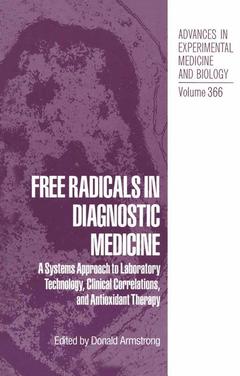Free Radicals in Diagnostic Medicine, 1994 A Systems Approach to Laboratory Technology, Clinical Correlations, and Antioxidant Therapy Advances in Experimental Medicine and Biology Series, Vol. 366
Langue : Anglais
Coordonnateur : Armstrong Donald

An International Syaposiua on Free Radicals in Diagnostic Medicine was co-sponsored by the state University of New York at Buffalo, Roswell Park Cancer Institute, and the Upstate NY Section of the American Association of Clinical Chemistry. The theme was "A Systems Approach To Laboratory Technology, Clinical Correlations And Antioxidant Therapy." The symposium was held on October 7-8, 1993 at the Hyatt Hotel and on October 9 at Roswell Park Cancer Institute, Buffalo, New York. This proceedings volume contains chapters from platform presentations, poster sessions and from invited special lectures in the areas of basic science, clinical applications and efficacy of treatment. A Special Lecture on the relevance of free radical analysis to clinical medicine was presented by Professor Kunio Yagi of Japan. The Yagi procedure to measure thiobarbituric acid (TBA) reaction reflects the amount of reactive substances, lipid peroxides and aldehydes, in the sample. For example, normal subjects will have less than 4 nmol/ml of serum lipid peroxides, while a person with diabetes generally has equal or greater than 5.0 and a diabetic person with vascular complications often exceeds 7.5 nmol/ml. Serum TBA is a clinically important measure that relates to aging, gender and estrogen as an antioxidant, in the prognosis for vascular disorders, and in pathological conditions relative to the amount of lipid peroxidation. The BASIC SCIENCES portion of the program examined: "Mechanisms of Action, Pathophysiology and Laboratory Tests" in six presentations.
Pathophysiology and Analysis.- Lipid Peroxides and Related Radicals in Clinical Medicine.- Reactive Oxygen Species in Normal Physiology, Cell Injury and Phagocytosis.- Free Radical Mechanisms for Chromosomal Instability in Bloom’s Syndrome.- The Analysis of Free Radicals, Lipid Peroxides, Antioxidant Enzymes and Compounds Related to Oxidative Stress as Applied to the Clinical Chemistry Laboratory.- Organ Specific Disorders.- Free Radicals and the Pathogenesis of Neuronal Death: Cooperative Role of Excitatory Amino Acids>.- Free Radicals and Ocular Disease.- Active Oxygen Mechanisms of UV Inflammation.- Oxygen-Free Radicals at Myocardial Level: Effects of Ischaemia and Reperfusion.- Mechanisms of Atherosclerosis: Role of LDL Oxidation.- Tissue Iron Overload and Mechanisms of Iron-Catalyzed Oxidative Injury.- Free Radicals in the Pathophysiology of Pulmonary Injury and Disease.- Lipid Peroxides in Hepatic, Gastrointestinal, and Pancreatic Diseases.- Reactive Oxygen Molecules in the Kidney.- Reactive Oxygen Species (ROS) and Reproduction.- Systemic Involvement.- Autoimmune and Inflammatory Diseases.- Antioxidants and Cancer: Molecular Mechanisms.- New Directions for Free Radical Cancer Research and Medical Applications.- Shock and Multiple Organ Failure.- Role of Nutrients in the Cause and Prevention of Oxygen Radical Pathology.- Involvement of Free Radical Mechanism in the Toxic Effects of Alcohol: Implications for Fetal Alcohol Syndrome.- Therapeutic Intervention.- 21-Aminosteroids (“Lazaroids”).- The Potential of Gliclazide, a Sulphonylurea to Influence the Oxidative Processes within the Pathogenesis of Diabetic Vascular Disease.- Interactions between Vitamin E, Free Radicals, and Immunity During the Aging Process.- Vitamins and Carotenoids — A PromisingApproach to Reducing the Risk of Coronary Heart Disease, Cancer and Eye Diseases.- Free Radical Scavenging and Antioxidant Activity of Plant Flavonoids.- Plasma Clearance and Immunologic Properties of Long-Acting Superoxide Dismutase Prepared Using 35,000 to 120,000 Dalton Poly-Ethylene Glycol.- Clinical Trials with Dismutec™ (Pegorgotein; Polyethylene Glycol-Conjugated Superoxide Dismutase; PEG-SOD) in the Treatment of Severe Closed Head Injury.- Poster Presentations.- A New Method for Detecting Lipid Peroxidation by Using Dye Sensitized Chemiluminescence.- Chemiluminescence and the Challenge to Attomole Detection.- Evidence Against Malondialdehyde Bound to Cellular Consituents in Phospholipid Peroxidation.- Evaluation of In Vivo Free Radical Activity During Endotoxic Schock Using Scavengers, Electron Microscopy, Spin Traps, and Electron Paramagnetic Spectroscopy.- Involvement of Hydroxyl Radicals in Endotoxin-Evoked Shock.- The Role of Nitric Oxide in Endotoxin-Elicited Hypodynamic Circulatory Failure.- In Vivo Evaluation of the Role of Neutrophil-Derived Free Radicals in the Development of Endotoxic Shock.- Photosensitized Formation of 8-Hydroxy-2’-Deoxyguanosine by A Cationic meso-Substituted Porphyrin.- Aging Associated Declines in the Antioxidant Enzymes of Human Testis.- Lipid Peroxidation in Normal Pregnancy and Preeclampsia.- Alkylation of Purine Bases By Carbon-Centered Radicals.- Cytochrome Biochemistry in Sheep Retina Following Exposure to Oxygen.- Cytochrome Oxidase Activity in the Fetal Sheep Retina.- Age-Related Phospholipid Hydroperoxide Levels in Gerbil Brain Measured by HPLC-Chemiluminescence Assay and Their Relation to Hydroxyl Radical Stress — Clinical Implications.- Lipid Peroxidation and Diabetic Complications: Effect of Antioxidant VitaminsC and E.- Vascular Complications of Patients in Kuwait with Type 2 Diabetes Mellitus (NIDDM) and Elevated Serum Lipid Peroxides.- Vascular and Cellular Protein Changes Precede Hippocampal Pyramidal Cell Loss Following Global Ischemia in the Rat.- Dietary Antioxidants and Breast Cancer Risk: Effect Modification by Family History.- Effect of MAK-4 and MAK-5 on Endothelial Cell- and Soyabean Lipoxygenase-Induced LDL Oxidation.- Prevention of Oxidant Stress by Student Rasayana(SR).- Biochemical Changes Induced by Maharishi Amrit Kalash (MAK-4) and MA-208 in Diet-Induced Hypercholesterolemic Rabbits.- In Vitro Ergothioneine Administration Failed to Protect Isolated Ischaemic and Reperfused Rabbit Heart.- Pentoxifylline Interferes with Potential Sources of Free Radical Generation During Endotoxemia.- Contributors.
Date de parution : 10-2012
Ouvrage de 464 p.
15.6x24.4 cm
Thèmes de Free Radicals in Diagnostic Medicine :
Mots-clés :
Lipid; Oxidation; antioxidant; cancer; chemistry; lipide; pathophysiology; physiology; research
© 2024 LAVOISIER S.A.S.



